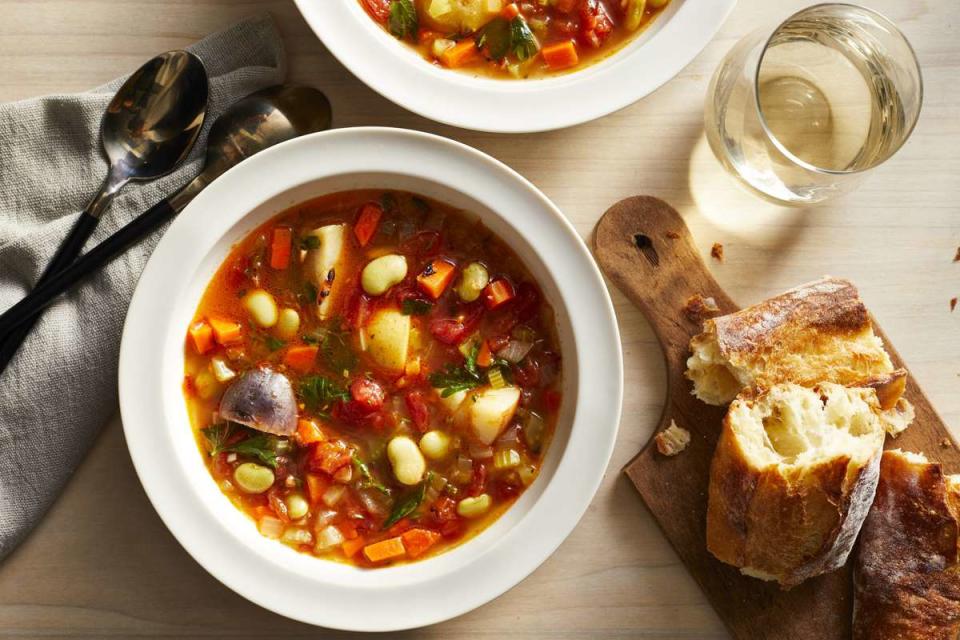How To Fix Salty Soup, According To The Professionals
TABLE OF CONTENTS
On This Page
How to Avoid Over-Salting Soup
How to Fix Salty Soup
Dilute the Broth
Soak Up the Salt
Balance Salt with Acid
There's nothing like a pot of homemade soup, especially on a chilly day. Not only is it delicious, but if you make a big batch, you can freeze and store soup for easy meals down the road. Sounds perfect, right? It is, until you take a taste and discover you've added too much salt to the pot, rendering it inedible. Don't throw away that soup just yet, though. It's easy to fix an oversalted soup. To find out how, we asked the experts who make delicious soups and other products at Fischer & Wieser in Fredericksburg, Texas.
How to Avoid Over-Salting Soup
The easiest way to avoid over-salting your soup is to taste it as you go. Add salt in small increments. Remember, you can always add more if it's not enough. Ashley Seelig, Director of Quality Assurance and Product Development at Fischer & Wieser, says you should also be aware of sneaky ingredients. "Broths and condensed soups are notorious for being salty," she says. She warns that many spice blends contain added salt, too. Be sure to read the labels of your ingredients. You may also have to avoid adding salt if you're cooking with sodium-filled meats like ham or bacon.

Alison Miksch; Prop Styling: Sarah Elizabeth Cleveland; Food Styling: Melissa Gray
How to Fix Salty Soup
If you've been too liberal with the salt shaker, don't fret: We have several methods to use for fixing your oversalted soup. Many involve adding more of an ingredient to dilute or balance out the salty flavor. Others involve adding an ingredient to soak up excess salt. Try one or more of these options to achieve the right balance in your broth and enjoy a perfectly seasoned soup.
Dilute the Broth
Any of these ingredients can dilute the salt in your broth very quickly. Add a little at a time, stir in, and taste, then repeat if needed. Choose which method to use depending on the ingredients already in your recipe (is your soup loaded with vegetables or creamy and smooth?) or add a new ingredient that will complement the flavors.
Add Water
Carolyn Brown, Executive Chef at Fischer & Wieser, says her favorite method for reducing salt is simply adding water. Be sure to add it in small increments, tasting as you go. If you find your soup is getting too thin, she suggests adding corn starch or flour to your water at a 1:1 ratio. She also adds, "for a cream-based soup such as potato soup, add more cream with the water."
Add Dairy
If you've got some dairy in the refrigerator, Brown says you're in luck. "One of the best ways to compensate for over-salting is to add dairy. Add a swirl of yogurt, heavy cream, or even sour cream." Feel free to use whatever you have on hand. The dairy can be added to the entire pot, or directly to the bowl before serving.
Add Broth
Both Seelig and Brown say adding broth to your soup is a great way to dilute the salt. If you have time, Seelig suggests making it yourself by boiling protein in water—just skip any salt in the recipe. If you're using store-bought broth, be sure to read the label to make sure there is as little sodium as possible.
Soak Up the Salt
Starches and grains are conveniently designed to absorb all the delicious flavors in your dishes. Adding one of these ingredients will reduce the saltiness in your soup, and we've even got a trick for soaking up and removing salt from your dish.
Soak Up the Salt with Potatoes
Try this method if you're making chowder or vegetable soup. Seelig suggests peeling a potato or two (or more depending on your pot size) and boiling them in the pot with your soup. Let them simmer for about 30 minutes to soak up the excess salt. When you're finished, just remember to remove the potatoes from your soup.
Add Starch
You can also use potatoes, pasta, or rice to tame the saltiness of your dish with the added bonus of turning your favorite soup into a hearty, filling meal. Dice potatoes and cook in the broth until fork-tender, which can take from 10 to 20 minutes. For pasta or rice, add a half cup to a cup to your soup, keeping in mind that it will expand. Simmer in the broth until it's soft enough to bite through but not mushy, which typically takes around 10 minutes.
Balance Salt with Acid
If you're worried about making your soup too bland, here's an option that will cut saltiness while adding flavor. Choose one or the other of our methods below, depending on whether you're looking for a gentle course correction or a full overhaul of your much-too-salty soup.
Add Lemon or Vinegar
A squeeze of lemon can balance out a mildly oversalted soup with its acidic flavor. A splash of vinegar can also do wonders for taming the salty flavor.
Add Tomatoes
Canned tomatoes will go even further because they add acidity while also diluting an oversalted soup. This method works especially well for soups that already have tomatoes on the ingredient list, such as minestrone, chili, or tortilla soup.

